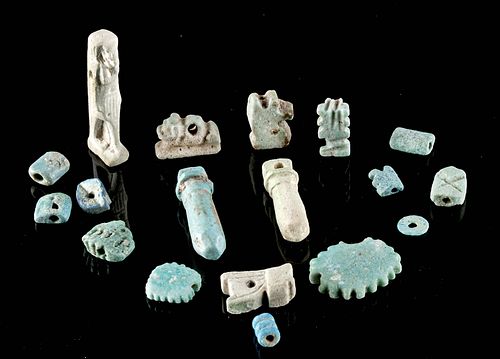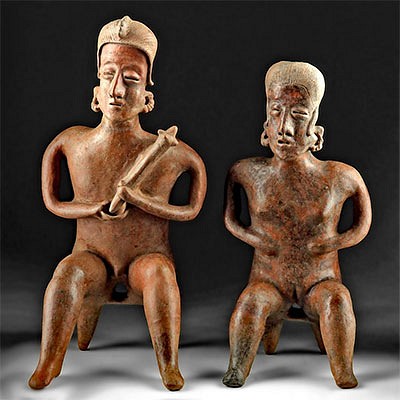18 Egyptian Glazed Faience Amulets / Beads
Lot 4
About Seller
Artemis Fine Arts
686 S Taylor Ave, Ste 106
Louisville, CO 80027
United States
Selling antiquities, ancient and ethnographic art online since 1993, Artemis Gallery specializes in Classical Antiquities (Egyptian, Greek, Roman, Near Eastern), Asian, Pre-Columbian, African / Tribal / Oceanographic art. Our extensive inventory includes pottery, stone, metal, wood, glass and textil...Read more
Estimate:
$1,500 - $2,000
Absentee vs Live bid
Two ways to bid:
- Leave a max absentee bid and the platform will bid on your behalf up to your maximum bid during the live auction.
- Bid live during the auction and your bids will be submitted real-time to the auctioneer.
Bid Increments
| Price | Bid Increment |
|---|---|
| $0 | $25 |
| $300 | $50 |
| $1,000 | $100 |
| $2,000 | $250 |
| $5,000 | $500 |
| $10,000 | $1,000 |
| $20,000 | $2,500 |
| $50,000 | $5,000 |
| $100,000 | $10,000 |
| $200,000 | $20,000 |
About Auction
By Artemis Fine Arts
Mar 25, 2021
Set Reminder
2021-03-25 10:00:00
2021-03-25 10:00:00
America/New_York
Bidsquare
Bidsquare : CLEARANCE Antiquities | Ethnographic Art
https://www.bidsquare.com/auctions/artemis-gallery/clearance-antiquities-ethnographic-art-6663
Featuring discounted pricing on Asian art, Classical antiquities from Egypt, Greece, Italy, and the Near East...plus Pre-Columbian, Tribal, Russian Icons, Spanish Colonial, Fine Art, more! Artemis Fine Arts info@artemisgallery.com
Featuring discounted pricing on Asian art, Classical antiquities from Egypt, Greece, Italy, and the Near East...plus Pre-Columbian, Tribal, Russian Icons, Spanish Colonial, Fine Art, more! Artemis Fine Arts info@artemisgallery.com
- Lot Description
**Originally Listed At $1200**
Ancient Egypt, Third Intermediate to Late Dynastic Period, 21st to 31st Dynasty, ca. 1070 to 332 BCE. A wonderful selection of faience beads covered in layers of blue and blue-green glaze. First is a standing effigy of Thoth, the ibis-headed god of writing, mathematics, and other intellectual pursuits. Next are two perfume vials with piriform bodies. A petite lion lays recumbent atop a plinth with a pierced loop on its back. Three rectangular beads and one ovoid bead have slender suspension holes and tapered lateral edge, and another five beads bear serrated peripheries. Also included are a fused triple bead, a wide bead with an incised 'X,' and a discoid bead. Last are a pair of wadjet (also wedjat, Eye of Horus) detailed with blue-green glaze. Size of largest (Thoth amulet): 0.9" H (2.3 cm)
Faience was known to the ancient Egyptians as "tjehnet," meaning brilliant or dazzling. It was made by grinding quartz or sand crystals together with various elements including copper oxide which gave the material its distinctive blue-green glaze color when fired. During the New Kingdom Period (ca. 1550 to 1070 BCE), new developments in glass production crossed over into faience craftsmanship and enabled a wider array of colors and shapes when forming compositions. Petite amulets and beads like these examples were perhaps buried with mummies or carried by individuals as apotropaic charms and symbols of increased luck.
Provenance: ex-Phoenicia Holyland Antiquities, New York, New York, USA, acquired 1990s to 2000s; ex-private M. Goodstein collection, New York, New York, USA, acquired in the 1990s
All items legal to buy/sell under U.S. Statute covering cultural patrimony Code 2600, CHAPTER 14, and are guaranteed to be as described or your money back.
A Certificate of Authenticity will accompany all winning bids.
We ship worldwide and handle all shipping in-house for your convenience.
#157294Thoth amulet repaired from two pieces with light adhesive residue along break lines; remaining pieces are intact and very good. All pieces have minor nicks to peripheries and softening to some finer details. Great preservation of glaze pigment throughout.Condition
- Shipping Info
-
All shipping is handled in-house for your convenience. Your invoice from Artemis Gallery will include shipping calculation instructions. If in doubt, please inquire BEFORE bidding for estimated shipping costs for individual items.
-
- Buyer's Premium



 EUR
EUR CAD
CAD AUD
AUD GBP
GBP MXN
MXN HKD
HKD CNY
CNY MYR
MYR SEK
SEK SGD
SGD CHF
CHF THB
THB














